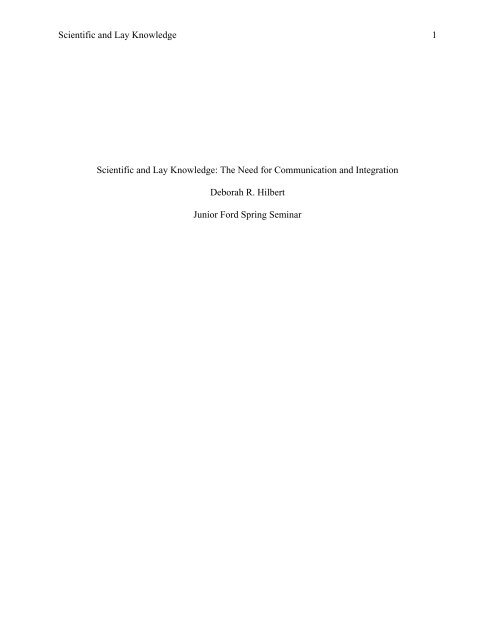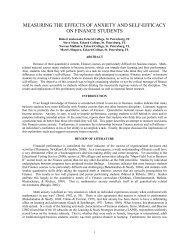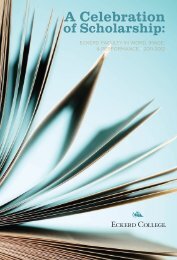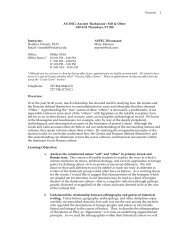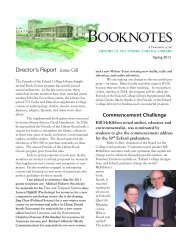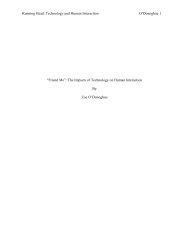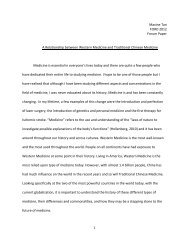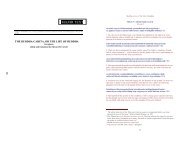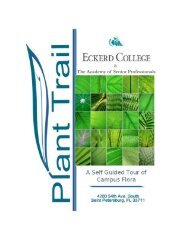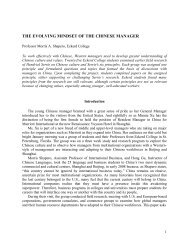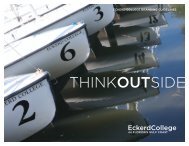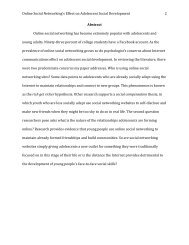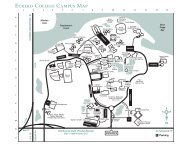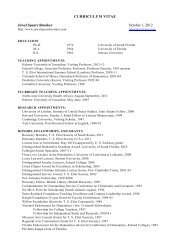Scientific and Lay Knowledge 1 Scientific and Lay Knowledge: The ...
Scientific and Lay Knowledge 1 Scientific and Lay Knowledge: The ...
Scientific and Lay Knowledge 1 Scientific and Lay Knowledge: The ...
Create successful ePaper yourself
Turn your PDF publications into a flip-book with our unique Google optimized e-Paper software.
<strong>Scientific</strong> <strong>and</strong> <strong>Lay</strong> <strong>Knowledge</strong> 1<br />
<strong>Scientific</strong> <strong>and</strong> <strong>Lay</strong> <strong>Knowledge</strong>: <strong>The</strong> Need for Communication <strong>and</strong> Integration<br />
Deborah R. Hilbert<br />
Junior Ford Spring Seminar
<strong>Scientific</strong> <strong>and</strong> <strong>Lay</strong> <strong>Knowledge</strong> 2<br />
Abstract<br />
Our modern world is defined by science <strong>and</strong> technology. <strong>Scientific</strong> knowledge, the peer-<br />
reviewed information acquired through systematic experimentation or pseudo-experimentation<br />
<strong>and</strong> analysis, alone cannot give a complete picture of our earth. Non-scientific lay knowledge,<br />
everyday knowledge acquired by all people outside of the methodology of science, also<br />
contributes to our underst<strong>and</strong>ing of the world around us. Despite the obvious merits of both<br />
scientific <strong>and</strong> non-scientific lay knowledge, scientific knowledge has come to be equated with<br />
expert knowledge, <strong>and</strong> the public has lost trust in science, strengthening the boundary between<br />
the two ways of knowing. Culture plays an important role in defining the differences between<br />
scientific <strong>and</strong> lay knowledge <strong>and</strong> perpetuating the boundary between the two. This paper<br />
discusses the scientific-lay boundary phenomenon, why the boundary needs to be broken, <strong>and</strong><br />
how this can be done. Integrating scientific <strong>and</strong> lay knowledge can make knowledge truly<br />
universal, <strong>and</strong> higher education facilitates this process by creating individuals who can<br />
communicate on both sides of the divide <strong>and</strong> find the common goals of scientific <strong>and</strong> lay<br />
communities as well as society as a whole.
<strong>Scientific</strong> <strong>and</strong> <strong>Lay</strong> <strong>Knowledge</strong> 3<br />
<strong>Scientific</strong> <strong>and</strong> <strong>Lay</strong> <strong>Knowledge</strong>: <strong>The</strong> Need for Communication <strong>and</strong> Integration<br />
Our modern world is defined by science <strong>and</strong> technology. Behind every household<br />
appliance, every pill in our medicine cabinet, every modified gene in our food, <strong>and</strong> even the<br />
management of our waste, there is a scientist working under scrutinized conditions to improve<br />
society. And yet, society was not always like this. In fact, there still remain some people who<br />
live in communities in which the scientific method is not applied to everyday life—<strong>and</strong> some<br />
argue cannot be (Harry, 2011). Even within our own fast-paced, technocratic culture lay<br />
knowledge is prevalent <strong>and</strong> pertinent. This is because scientific knowledge, the information<br />
acquired through systematic experimentation or pseudo-experimentation <strong>and</strong> analysis that is<br />
peer-reviewed by other trained scientists, does not give a complete picture of our earth. Non-<br />
scientific knowledge, everyday knowledge acquired by all people outside of the methodology of<br />
science, also contributes to our underst<strong>and</strong>ing of the world around us.<br />
<strong>Scientific</strong> knowledge aids in the globalization process by giving people an ability to<br />
participate in the world economy. Of the five reasons to promote school science education listed<br />
by the National Research Council, the dependence of economic competitiveness on scientific<br />
capacity was one (Liu, 2008, p. 304). According to health researcher Peter Harvey (2009),<br />
scientific knowledge is significant because it is open, verifiable <strong>and</strong> refutable through a<br />
methodology that requires review (Harvey, 2009, p.629). Science is an evolving process, <strong>and</strong><br />
contrary to common belief, scientific knowledge is created to be changed.<br />
Non-scientific lay knowledge is important because it is oftentimes well-adapted to local<br />
conditions <strong>and</strong> people. Teresa Johnson (2010) found through her fisheries management study<br />
that fishermen had a substantial amount of knowledge about the local fisheries that scientists did<br />
not possess, including information about sea depth <strong>and</strong> ecosystem interactions (Johnson, 2010).
<strong>Scientific</strong> <strong>and</strong> <strong>Lay</strong> <strong>Knowledge</strong> 4<br />
Traditional Indigenous knowledge is an important example of lay knowledge <strong>and</strong> is beneficial<br />
because it is less “compartmentalized” <strong>and</strong> “reductionist,” as Debra Harry puts it, than Western<br />
scientific knowledge, <strong>and</strong> therefore contributes to a interconnected underst<strong>and</strong>ing of property <strong>and</strong><br />
life processes (Harry, 2011, p. 722). <strong>Lay</strong> knowledge is significant in that it is generated by non-<br />
experts, is available to experts <strong>and</strong> non-experts alike, <strong>and</strong> its constraints appear only in the<br />
structure of the culture of origin.<br />
Despite the obvious merits of both types of knowledge, scientific knowledge has come to<br />
be equated with expert knowledge, <strong>and</strong> the public has lost trust in science, strengthening the<br />
boundary between the two ways of knowing. This paper discusses this phenomenon, why this<br />
boundary needs to be broken, <strong>and</strong> how this can be done. Integrating scientific <strong>and</strong> lay knowledge<br />
can make knowledge truly universal, <strong>and</strong> higher education facilitates this process by creating<br />
individuals who can communicate on both sides of the divide <strong>and</strong> find the common goals of<br />
scientific <strong>and</strong> lay knowledge.<br />
<strong>The</strong> Danger of Emphasizing One Type of <strong>Knowledge</strong><br />
Recently in our history, there has been a paradigm shift in thought that has redefined<br />
scientific knowledge as expert knowledge. <strong>The</strong>re are dangers in placing too much emphasis in<br />
one kind of knowledge, however. Results include inequality between the perception <strong>and</strong><br />
treatment of types of knowledge <strong>and</strong> those who most often utilize them as well as a lack of<br />
universality <strong>and</strong> objectivity in science, both of which contribute to a science-lay divide.<br />
<strong>Scientific</strong> literacy is almost forced upon society because of its necessity in national development.<br />
In his paper on scientific literacy <strong>and</strong> the public, Xiufeng Lui (2009) points out the question of<br />
whether imposing scientific literacy on students is moral because it makes humans a means to<br />
the economic ends of others (Lui, 2009, p. 306). Overemphasizing scientific knowledge can lead
<strong>Scientific</strong> <strong>and</strong> <strong>Lay</strong> <strong>Knowledge</strong> 5<br />
to ethical dilemmas. Science seems to pervade all aspects of our lives, while lay knowledge is<br />
often viewed as illegitimate without scientific verification <strong>and</strong> ownership. <strong>The</strong>re is a top-down<br />
approach to acquiring <strong>and</strong> presenting knowledge in which scientists <strong>and</strong> associated bureaucrats<br />
are at the top <strong>and</strong> the public the bottom. This does not leave room for the input of local <strong>and</strong><br />
indigenous peoples’ knowledge in research <strong>and</strong> decision-making (Backstr<strong>and</strong>, 2003, p. 29). <strong>Lay</strong><br />
knowledge can lack the fundamental scope <strong>and</strong> intricate details that one acquires through<br />
scientific practice, as well as an underst<strong>and</strong>ing of hypothesizing <strong>and</strong> experimental design useful<br />
in problem-solving <strong>and</strong> critical thinking. However, laypeople are too often seen as ignorant <strong>and</strong><br />
unequal, <strong>and</strong> this aids heavily in creating the divide between the scientific <strong>and</strong> lay communities.<br />
What is most interesting is the epistemological analysis of scientific knowledge,<br />
especially as it is viewed by higher learning institutions. <strong>Scientific</strong> knowledge is seen as being of<br />
higher quality than everyday knowledge because of its systematized character in accumulating<br />
information. This leads to the question of whether one form of knowledge can be privileged over<br />
another. Science is a process of asking questions <strong>and</strong> building upon or disproving existing ideas.<br />
This is just like any other form of human knowing—riddled with mistakes. Claiming that science<br />
can be universally applied to the world would mean it must be accepted in every aspect of the<br />
world, but plenty of people <strong>and</strong> cultures do not accept scientific explanations for certain things.<br />
Science can only be objective if it applies to everyone, but marginalized groups, whether women,<br />
socio-economically poor people, or indigenous people, often distrust scientific inquiries <strong>and</strong><br />
findings. This distrust can stem from the wrong-doings of the states the scientists represent, the<br />
inability of laypeople to make sense of scientific knowledge culturally, or simply a lack of<br />
communication <strong>and</strong> involvement of the marginalized group. Placing too much emphasis in<br />
scientific knowledge further hinders the formation of an adaptable, multi-faceted knowledge.
<strong>Scientific</strong> <strong>and</strong> <strong>Lay</strong> <strong>Knowledge</strong> 6<br />
<strong>The</strong> Boundary <strong>and</strong> Its Implications for Society<br />
<strong>The</strong> boundary between scientific <strong>and</strong> lay knowledge is built by overemphasis on<br />
scientific knowledge as described above, a lack of science literacy in the public, <strong>and</strong> overall<br />
cultural misunderst<strong>and</strong>ing. Despite the prevalence <strong>and</strong> favoring of scientific knowledge in our<br />
world, science literacy levels are relatively poor for both students <strong>and</strong> adults (Lui, 2009, p.304).<br />
This could be a result of inadequate education, as well as the pre-existing barriers to scientific<br />
knowledge mentioned earlier.<br />
Cultural misunderst<strong>and</strong>ing between the scientific community <strong>and</strong> lay communities<br />
contributes greatly to the divide in knowledge. According to Heidi Grasswick (2010), professor<br />
of Philosophy at Middlebury College, the non-scientific public wants to know that scientific<br />
knowledge is reliable, ethical <strong>and</strong> shared with society (Grasswick, 2010, p.395). Science is not<br />
perfect, however, so when miscalculations are made or rogue scientists publicized, it is easy for<br />
the public to lose faith in scientists <strong>and</strong> scientific knowledge. Sometimes scientific explanations<br />
can run counter to existing cultural beliefs, in which case time <strong>and</strong> careful explanations are<br />
needed in order for a community to underst<strong>and</strong> <strong>and</strong> find a place for the new information in their<br />
system of beliefs (Grasswick, 2010). If the barrier we are seeing is indeed a social <strong>and</strong> cultural<br />
construct, then societies <strong>and</strong> their cultures can break it down—a process I believe should happen<br />
sooner than later.<br />
Breaking the Barrier: <strong>The</strong> Benefits of Integration<br />
Breaking the barrier means integrating the two sources of information into a collaborative<br />
system of data acquisition, analysis, <strong>and</strong> sharing. Such a process can lead to the realization of<br />
common goals, the empowerment of previously ignored sources of knowledge, <strong>and</strong> improved<br />
problem solving. We live in an increasingly complex world, which calls for more
<strong>Scientific</strong> <strong>and</strong> <strong>Lay</strong> <strong>Knowledge</strong> 7<br />
interdisciplinary <strong>and</strong> open-ended approaches to problems. Science alone cannot offer open-ended<br />
answers because it focuses on such limited, specific topics, while everyday knowledge needs the<br />
methodology <strong>and</strong> precision of science. Benefits of the integration of scientific <strong>and</strong> local<br />
knowledge have already been observed in conservation efforts of reindeer in Sweden <strong>and</strong><br />
Bonefish in Kiribati, where traditional ecological knowledge (TEK) is incorporated into<br />
scientific studies (Ramstad et al., 2006). <strong>The</strong> public <strong>and</strong> indigenous peoples involved in the<br />
scientific process feel empowered through their inclusion, <strong>and</strong> the transparency in the science<br />
can allow scientists to gain back trust from the public. Science gains its true meaning for the<br />
majority of society when it is applicable to people <strong>and</strong> specific situations or contexts. In order to<br />
be applicable to people, scientific research must incorporate the knowledge local laypeople<br />
possess. This in turn contributes to the creation of a more universal, versatile knowledge.<br />
How to Integrate<br />
Communication, the realization of common goals, <strong>and</strong> collaborative research can help<br />
integrate scientific <strong>and</strong> everyday knowledge. Improved communication includes making<br />
scientific findings <strong>and</strong> processes available <strong>and</strong> underst<strong>and</strong>able to the public. This is done, in part,<br />
by promoting scientific literacy as well as presenting scientific findings to the public in clear <strong>and</strong><br />
timely manners. Scientists need to underst<strong>and</strong> the people for whom their research is relevant <strong>and</strong><br />
to recognize the importance of these people’s input in creating a comprehensive picture of the<br />
situation. Both scientists <strong>and</strong> members of the public must recognize the common goals that link<br />
them, including desires to better underst<strong>and</strong> the environment, life processes, threats to well-<br />
being, <strong>and</strong> conservation. Ramstad et al. found in their study of Maori traditional ecological<br />
knowledge (TEK) of the Tuatara (the only remaining members of an order of ancient reptiles)<br />
that scientists <strong>and</strong> practitioners of TEK share the common goal of the conservation of the
<strong>Scientific</strong> <strong>and</strong> <strong>Lay</strong> <strong>Knowledge</strong> 8<br />
Tuatara, a phenomenon also experienced by researchers in different locations with different<br />
conservation threats (Ramstad et al., 2006, p. 456). Pinpointing theses common goals encourages<br />
more trust <strong>and</strong> makes collaboration more possible.<br />
Cooperative research is a method of involving non-scientists who possess knowledge on<br />
a topic in the research process. Teresa Johnson (2010) described a process of translating the<br />
knowledge of fishermen into scientific knowledge by means of a cooperative research project in<br />
the northeast U.S. (Johnson, 2010). As a result of the cooperative research, fishermen’s<br />
knowledge was incorporated into the management <strong>and</strong> decision-making process, fishermen<br />
found it easier to participate in management discussions, <strong>and</strong> both scientists <strong>and</strong> fishermen found<br />
increased levels of trust <strong>and</strong> underst<strong>and</strong>ing of each other’s motives (Johnson, 2010). Although<br />
the non-scientists still found their knowledge to be subject to legitimization by scientists, they<br />
gained the means to carry out future collaborations with scientists <strong>and</strong> resource managers<br />
concerning something that is important to their lifestyles (Johnson, 2010). Ramstad et al.<br />
determined that TEK provided a rich source of information on a highly threatened <strong>and</strong> little-<br />
studied organism, <strong>and</strong> discrepancies between natives’ knowledge of the Tuatara <strong>and</strong> scientific<br />
findings provided direction for further research on conservation of the species (Ramstad et al.,<br />
2006, p. 462). No single explanation of the world is complete, <strong>and</strong> by incorporating different<br />
worldviews in research, even if only through the collaboration of non-scientists in the research<br />
process beginning to end, it becomes easier to view the world holistically—not as a series of<br />
systems <strong>and</strong> theories but as a tapestry of relationships.<br />
<strong>The</strong> Role of Higher Education in Spanning the Boundary<br />
Higher education has a unique role in breaking down the barrier that has developed<br />
between scientific knowledge <strong>and</strong> lay knowledge. Higher educational institutions must first make
<strong>Scientific</strong> <strong>and</strong> <strong>Lay</strong> <strong>Knowledge</strong> 9<br />
scientific literacy a goal as it allows individuals to underst<strong>and</strong>, critically examine, <strong>and</strong> relate<br />
scientific findings. It even permits individuals to change the process of scientific research to<br />
incorporate collaboration with scholars of different disciplines <strong>and</strong> with the laypeople whom the<br />
research most directly affects. It also means individuals can participate fully in modern society,<br />
taking leadership positions in a world increasingly affected by science.<br />
Universities <strong>and</strong> colleges can train thinkers who are scientifically literate <strong>and</strong> possess the<br />
skills to ask proper questions, consider different viewpoints, problem-solve <strong>and</strong> communicate<br />
effectively on <strong>and</strong> for both sides of the science-lay divide. Individuals like these are whom<br />
Johnson (2010) calls “boundary spanners,” <strong>and</strong> they include scientists as well as non-scientists<br />
who possess thorough underst<strong>and</strong>ings of the complex issues at h<strong>and</strong> <strong>and</strong> language aptitude<br />
(Johnson, 2010, 267). <strong>The</strong>se “boundary spanners” can then go on to facilitate continued<br />
discussions between scientists <strong>and</strong> the public. <strong>The</strong>y can also teach the public formally (as in<br />
educational institutions) or informally (in workshops, council meetings, museums, etc.) in order<br />
to increase the scientific literacy of the public, thereby giving more power to the public to<br />
participate in resource management <strong>and</strong> decision-making processes that are relevant to them.<br />
Colleges <strong>and</strong> universities have been contributors to the idea that scientific knowledge is<br />
more legitimate or noteworthy than everyday knowledge by means of their place as the sole<br />
trainers of scientific researchers over the centuries as well as their ability to define scientific<br />
knowledge itself. This idea relates to the discussion by Gert Biesta (2007) of the Institute of<br />
Education at the University of Stirling of the “knowledge monopoly” of higher education, <strong>and</strong><br />
requires that higher education institutions recognize their epistemological power (Biesta, 2007, p.<br />
478). Training students to carry out work that is underst<strong>and</strong>able <strong>and</strong> relatable to the lay
<strong>Scientific</strong> <strong>and</strong> <strong>Lay</strong> <strong>Knowledge</strong> 10<br />
community is one way to go about ensuring that colleges <strong>and</strong> universities do not abuse their role<br />
as the trainers <strong>and</strong> definers of experts.<br />
Conclusion<br />
<strong>The</strong> world today is increasingly globalized <strong>and</strong> economy-driven. We are facing<br />
environmental crises like global warming that threaten every member of the human species. This<br />
means that there needs to be more collaborative efforts in problem-solving <strong>and</strong> decision-making<br />
involving scientists <strong>and</strong> the public because both are in danger <strong>and</strong> both have knowledge to<br />
contribute. In order to approach these increasingly complex issues, science must become as<br />
universal as it has been claimed to be, incorporating the adaptive strategies of local <strong>and</strong><br />
indigenous peoples’ knowledge into the scientific process. If we are to claim to be democratic or<br />
just supporters of all peoples’ rights, we have to give credit to all types of knowledge <strong>and</strong> allow<br />
the public to participate in the scientific process <strong>and</strong> subsequent decision-making processes. <strong>The</strong><br />
university has the power to create a generation of “boundary spanners” who can aid in the<br />
communication between the scientific <strong>and</strong> non-scientific spheres in problem-solving. <strong>The</strong>se<br />
“boundary spanners” can encourage a continued conversation on the benefits of a new kind of<br />
knowledge that considers the interconnected quality that life seems to possess when looking at it<br />
through so many lenses at once.
<strong>Scientific</strong> <strong>and</strong> <strong>Lay</strong> <strong>Knowledge</strong> 11<br />
References<br />
Backstr<strong>and</strong>, K. (2003). Civic Science for Sustainability: Reframing the Role of Experts, Policy-<br />
Makers <strong>and</strong> Citizens in Environmental Governance. Global Environmental Politics, 3(4),<br />
24-41.<br />
Biesta, G. (2007). Towards the knowledge democracy? <strong>Knowledge</strong> production <strong>and</strong> the civic role<br />
of the university. Studies in Philosophy <strong>and</strong> Education, 26(5), 467-479.<br />
Grasswick, H. E. (2010). <strong>Scientific</strong> <strong>and</strong> lay communities: earning epistemic trust through<br />
knowledge sharing. Synthese, 177, 387-409.<br />
Harry, D. (2011). Biocolonialism <strong>and</strong> Indigenous <strong>Knowledge</strong> in United Nations Discourse.<br />
Griffith Law Review, 20(3), 702-728.<br />
Harvey, P. W. (2009). Science, research <strong>and</strong> social change in Indigenous health—evolving was<br />
of knowing. Australian Health Review, 33(4), 628-635.<br />
Johnson, T. R. (2010). Cooperative research <strong>and</strong> knowledge flow in the marine commons:<br />
Lessons from the Northeast United States. International Journal of the Commons, 4(1),<br />
251-272.<br />
Liu, X. (2008). Beyond Science Literacy: Science <strong>and</strong> the Public. International Journal of<br />
Environmental & Science Education, 4(3), 301-311.<br />
Ramstad, K. M., Nelson, N. J., Paine, G., Beech, D., Paul, A., Paul, P., …Daugherty, C. H.<br />
(2006). Species <strong>and</strong> Cultural Conservation in New Zeal<strong>and</strong>: Maori Traditional Ecological<br />
<strong>Knowledge</strong> of Tuatara. Conservation Biology, 21(2), 455-464.<br />
Sava, M. (2011). Public Underst<strong>and</strong>ing of Science: Science PR <strong>and</strong> Popular Culture. Romanian<br />
Journal of Journalism & Communication, 6(1), 5-13.


